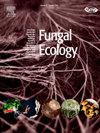Occurrence of Psychrophilomyces antarcticus in the Arctic
IF 2.2
3区 环境科学与生态学
Q3 ECOLOGY
引用次数: 0
Abstract
The fungus Psychrophilomyces antarcticus M.M. Wang & Xing Z. Liu, previously known only from the Qinghai-Tibet Plateau and Antarctica, was isolated in the Arctic from sediments on the littoral of the Kara Sea (Shokalsky Island) and represented by strains VKM F-5025/CBS 151455 and VKM F-5026/CBS 151456. The macro- and micro-morphology of the isolate was studied together with partial sequences of the DNA regions ITS, LSU, TEF1, and β-TUB, as well as the optimal values for temperature, pH and salinity. Slight differences between our two isolates and previously known strains of P. antarcticus were found in morphology (colony color and shape, size of phialides and spores) and physiological traits (optimal growth temperature, range of acceptable temperature and pH values for growth, colony odor, and degree of mucosity under extreme conditions). However, the high similarity in the sequenced conservative DNA sequences from 100 to 97% indicates that these slight morphological and physiological variations of the studied strains of P. antarcticus are intraspecific variation. Our study demonstrates that P. antarcticus is a cold-adapted poly-extreme tolerant species that can occur and function in extremely cold areas, such as high alpine, Antarctic, and Arctic regions.
南极嗜冷菌在北极的发生
真菌南极嗜冷菌M.M. Wang &;Xing Z. Liu,以前只在青藏高原和南极洲发现,在北极从喀拉海(Shokalsky岛)沿岸的沉积物中分离出来,以菌株VKM F-5025/CBS 151455和VKM F-5026/CBS 151456为代表。研究了分离菌株的宏观和微观形态,以及ITS、LSU、TEF1和β-TUB区域的部分序列,以及温度、pH和盐度的最佳值。我们的两个分离株与以前已知的南极p.a nticus菌株在形态学(菌落颜色和形状,philides和孢子的大小)和生理性状(最佳生长温度,生长的可接受温度和pH值范围,菌落气味和极端条件下的粘液程度)方面存在细微差异。然而,保守DNA序列在100 ~ 97%的高度相似性表明,这些微小的形态和生理变异是种内变异。我们的研究表明,南极拟南芥是一种适应寒冷的多极端耐受物种,可以在高寒、南极和北极等极寒地区生存和发挥作用。
本文章由计算机程序翻译,如有差异,请以英文原文为准。
求助全文
约1分钟内获得全文
求助全文
来源期刊

Fungal Ecology
环境科学-生态学
CiteScore
5.80
自引率
3.40%
发文量
51
审稿时长
3 months
期刊介绍:
Fungal Ecology publishes investigations into all aspects of fungal ecology, including the following (not exclusive): population dynamics; adaptation; evolution; role in ecosystem functioning, nutrient cycling, decomposition, carbon allocation; ecophysiology; intra- and inter-specific mycelial interactions, fungus-plant (pathogens, mycorrhizas, lichens, endophytes), fungus-invertebrate and fungus-microbe interaction; genomics and (evolutionary) genetics; conservation and biodiversity; remote sensing; bioremediation and biodegradation; quantitative and computational aspects - modelling, indicators, complexity, informatics. The usual prerequisites for publication will be originality, clarity, and significance as relevant to a better understanding of the ecology of fungi.
 求助内容:
求助内容: 应助结果提醒方式:
应助结果提醒方式:


